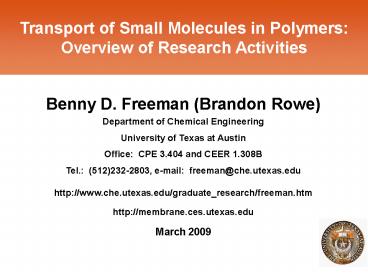Transport of Small Molecules in Polymers: PowerPoint PPT Presentation
1 / 19
Title: Transport of Small Molecules in Polymers:
1
Transport of Small Molecules in
Polymers Overview of Research Activities
Benny D. Freeman (Brandon Rowe) Department of
Chemical Engineering University of Texas at
Austin Office CPE 3.404 and CEER 1.308B Tel.
(512)232-2803, e-mail freeman_at_che.utexas.edu htt
p//www.che.utexas.edu/graduate_research/freeman.h
tm http//membrane.ces.utexas.edu March 2009
1
2
Freeman Research Group Focus
Develop fundamental structure/function rules to
guide the preparation of high performance
polymers or polymer-based materials for gas and
liquid separations as well as barrier packaging
applications.
3
Freeman Research Group Profile
- 21 Ph.D. students
- Gas Separations Brandon Rowe, Victor Kusuma,
Grant Offord, Tom Murphy, James Kyzar, Katrina
Czenkusch, David Sanders, Zach Smith - Liquid Separations Alyson Sagle, Bryan
McCloskey, Hao Ju, Yuan-Hsuan Wu, Lauren
Greenlee, Liz Van Wagner, Wei Xie, Dan Miller,
Joe Cook, Geoff Geise, Michelle Oh - Barrier Materials Richard Li, Kevin Tung
- 1 Postdoc Dr. Claudio Ribeiro
- Sponsors
- NSF - 5 projects
- DOE 2 projects
- Office of Naval Research - 1 project
- Sandia - 1 project
- Industrial sponsors Air Liquide, Kuraray, Kraton
Polymers, ConocoPhillips, Statkraft, Dow Water
Solutions
4
Collaborations
- University of Texas
- Don Paul (Chem. Eng.), Roger Bonnecaze (Chem.
Eng.). Mukul Sharma (Petroleum Eng.), Des Lawler
(Env. Eng.), Andy Ellington (Biochemistry) - Prof. Eric Baer, Anne Hiltner, Dave Schiraldi
(Case Western Reserve Univ.) - Prof. Jim McGrath (Virginia Tech)
- Prof. Doug Kalika (Univ. of Kentucky)
- Prof. Todd Emrick (Univ. of MA, Amherst)
- Dr. Anita Hill (CSIRO, Melbourne, Australia)
- Prof. Giulio Sarti (Univ. of Bologna, Italy)
- Prof. Philippe Moulin (Univ. Paul Cézanne,
Aix-en-Provence, France) - Prof. Young Moo Lee (Hanyang Univ., Seoul, Korea)
- Prof. Toshio Masuda (Kyoto Univ., Kyoto, Japan)
5
Spreading Water Shortage
Science 313, 1088-1090, 2006
5
6
Magnitude of the Problem
- Over 1 billion people live without access to
reliable drinking water. - 2.3 billion people (41 of the Earths
population) live in water stressed areas
expected to increase to 3.5 billion by 2025. - Annual global costs in excess of 100 billion in
medical costs and loss of productivity.
Science 313, 1088-1090, 2006
7
Why Chlorine is Used in Water Treatment
- Bacteria-laden untreated water kills more than
3.4 million people every year in developing
countries.1 - Un-disinfected water causes biofouling of
desalination membranes. - Chlorine is the most economical disinfectant for
deactivation of pathogenic microorganisms in
drinking water. - Over 98 of all water treatment facilities in the
U.S. disinfect water with chlorine and
chlorine-based products. - But the problem is
- Chlorine degrades desalination membranes,
reducing salt rejection and membrane lifetime.
7
1Houston Chronicle, Jan.8, 2005
www.americanchemistry.com/chlorine/
8
Chlorine Attacks Desalination Membranes
OCl-
HOCl
Chlorine as hypochlorous acid pH lt 5.5
Chlorine as hypochlorite pH gt 8.5
Membranes A-D commercial polyamide membranes
T. Knoell, Ultrapure Water, April 2006, pp. 24-31
8
9
Current Desalination Process
Feed water
Chlorinate (0.2-5 ppm)
Dechlorinate (Free chlorine lt 0.01 ppm)
Polyamide desalination membrane
Rechlorinate (1-2 ppm)
To protect membranes from chlorine
Product water
Desalination 64 (1987) 411 Desalination 124
(1999) 251
9
10
Disulfonated Polysulfone Membranes Exhibit High
Chlorine Tolerance
Hydrophilic block
Hydrophobic block
- High water permeability
- High chlorine tolerance
- Excellent fouling-resistance
- Good reproducibility
H.B. Park, B.D. Freeman, Z.B. Zhang, M. Sankir,
and J.E. McGrath, Highly Chlorine-Tolerant
Polymers for Desalination, Angew. Chem.-Int.
Edit. 47 6019-6024 (2008)
10
11
Potential Desalination Process Using
Chlorine-Tolerant Membranes
Chlorinate
New membrane
Feed water
Product water
- Extend membrane lifetime
- Simplify maintenance and operation
- Process intensification
- Cost savings via elimination of dechlorination
required by current membranes
11
12
Research in Water Purification Appears to be
Gaining Traction in the Scientific Community
13
New Gas Separation Membrane Materials with
Performance Better than Conventional Membranes
Science, vol. 318, 12 October 2007, pp. 254-258.
14
Science, vol. 318, 12 October 2007, pp. 254-258.
15
Beating the Permeability-Selectivity Tradeoff
for H2 Purification
Lin et al., Science, 311, pp. 639-642 (2006).
16
CO2 Selective Materials
17
Using Nanocomposites to Enhance Membrane
Separations
18
Using Nanolayering to Enhance Gas Barrier
Properties
19
Student Contacts

